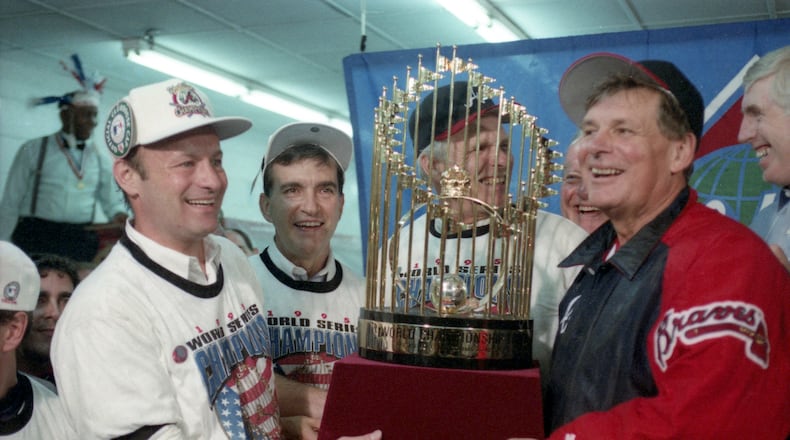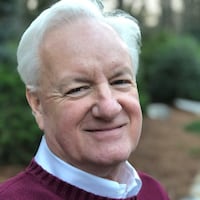Thirty years ago, the Braves had an uninspiring, unsuccessful season on the field, losing 97 games and finishing last in the National League West.
But during the summer and fall of 1990, they made a series of moves that overshadowed the season’s losses, setting up the organization for its historic run that began a year later.
The moves, all within a 129-day span, included the return of Bobby Cox from the front office to the dugout as manager, the hiring of John Schuerholz to replace Cox as general manager, the drafting of Chipper Jones and the painful trade of 1980s star Dale Murphy to open a spot in the outfield for 1990s star David Justice.
You’d be hard-pressed to find another year in Braves history with so many momentous decisions.
They turned out to be the right moves made at the right times.
“Before 1990, we had spent four years building up our system, and we thought we were getting really close,” recalled Stan Kasten, the Braves’ president from 1986-2003 and now the Los Angeles Dodgers’ president and CEO. “I mean, in 1990, I know we finished last, but our team really was on the brink of having success.”
The success that followed – winning an unprecedented 14 consecutive division titles from 1991-2005, winning the National League pennant five times in the 1990s and winning the World Series in 1995 -- required the decisions of 1990.
Moving Cox to dugout
As general manager since 1986, Cox had emphasized the procurement and development of young pitchers. But by June 1990, the Braves were on their way to a third consecutive last-place finish, and Kasten knew it was time for Cox to get back to the manager’s job he had done for the Braves from 1978-81 and for the Toronto Blue Jays from 1982-85.
“I asked him point-blank a hundred times: ‘Do you want to be a manager again?’” Kasten said in a recent interview from Los Angeles International Airport, where he was awaiting a flight to Atlanta for a weekend at the home he still has in Sandy Springs. “He always gave me the same answer: ‘Whatever you and Ted (Turner) want.’ I’d say, ‘No, Bobby, give me an answer.’ He would never do that because he wanted to be supportive of first Chuck (Tanner) and then Russ (Nixon).”
Tanner and Nixon were the Braves’ managers while Cox was GM, Tanner for two-plus seasons and then Nixon from May 1988 until Cox’s return to the dugout on June 22, 1990.
“My hope was that I could hold off until the following winter to put Bobby back in the dugout,” Kasten said. “I really struggled with putting him in for half a season with a team that was not performing well, wondering if that would undermine his credibility with our fans. But I just thought it was time.
“I knew I wanted him to be the manager. And I felt, even though he would never give me a straight answer, he wanted to be a manager again.”
Cox served as both manager and general manager for the final three-plus months of the 1990 season, but Kasten had made it clear to him he’d keep one of the jobs – not both -- beyond that season.
Soon after Cox returned to the dugout, Kasten said, “I very quietly started looking for a GM.”
Hiring Schuerholz
One morning late that summer, MLB’s “player personal development” committee met in New York. Among the committee members: Kasten and the Kansas City Royals’ highly regarded general manager, Schuerholz. They didn’t yet know each other well, but both decided to pass the time before their flights home by attending an afternoon game at Yankee Stadium.
“I had a car, and Stan didn’t, so I said, ‘Come on, I’ll give you a ride,’” Schuerholz recalled in a recent interview from his Truist Park office overlooking The Battery Atlanta.
Schuerholz and Kasten discussed a range of topics during their visit to Yankee Stadium, including the poor condition of the field at Atlanta-Fulton County Stadium and the Braves’ search for a general manager. Kasten asked Schuerholz for advice on the GM search.
Schuerholz: “I gave him a couple of names.”
Kasten: “He and I would talk off and on, once a week, twice a week, over the next month. Then in September, whoa, he asked me one question too many.”
Schuerholz: “He called me back in about three days and said, ‘You’re asking a lot of questions about this job. Would you have interest in it?’ And I answered him, ‘I might.’”
Kasten: “Once I learned that, thought this could really be happening, that was my first choice by a long shot.”
Schuerholz was attracted by the challenge, the Braves’ pipeline of prospects and Cox’s presence as manager, and he also felt some unease about changes afoot in the Kansas City organization.
“This,” Schuerholz said of the Atlanta job, “seemed like it had a chance to be very successful and joyful.”
But it was a tough decision for him because of his history with the Royals, whom he helped build from an expansion franchise to the 1985 World Series champions.
Two days before he decided to accept the Braves job, Schuerholz turned it down.
“It was on a Friday, the day I thought we were going to close the deal,” Kasten said. “John was, ‘I just can’t do it. I can’t leave Kansas City,’ yada, yada, yada. I was bummed because I was going to have to go in Monday and hire my second choice.
“On Sunday morning, I was out at the gym when John called my home. He asked my wife Helen, ‘How’s Stan?’ She said, ‘Well, he’s been a little down, John.’ He asked, ‘Has he hired anyone yet?’
“I called him back, and he goes, ‘Stan, you know, I think I made a mistake.’ And I go, ‘You’re right, John, you did.’”
On Oct. 10, 1990, Schuerholz was introduced in Atlanta as the Braves’ general manager.
The baseball industry was taken aback that he would leave the Royals for the Braves, who Kasten conceded “didn’t have the world’s best reputation back then.” Schuerholz remembers getting a call from Al Rosen, then the San Francisco Giants’ general manager.
“He asked me if I had fallen and hit my head,” Schuerholz said.
Schuerholz served as the Braves’ general manager through the 2007 season, and Cox managed the team through 2010. Both became Hall of Famers. Over the 17 seasons they worked together as manager and GM, the Braves had baseball’s best record.
“We hit the bull’s eye with both of those hirings,” Kasten said.
Drafting Chipper
Part of the reason for the success shared by Cox and Schuerholz was the Braves’ drafting of a high school shortstop from Pierson, Fla., in June 1990.
For months before that draft, the Braves were enamored with a hard-throwing high school pitcher from Texas named Todd Van Poppel. But Van Poppel insisted he was going to college and wouldn’t sign, and GM Cox eventually decided not to risk the No. 1 pick on him.
“I remember telling Bobby, ‘If you want to take Van Poppel and dare him to turn down the money, I’ll be right with you,’” Kasten said. “But Bobby said, ‘No, I don’t want to do that, because my second choice might be an even better player.’”
On June 2, 1990, the day of Jones’ high school graduation and prom, the Braves dispatched scouts Tony DeMacio and Dean Jongewaard to meet with him and his parents.
As Jones tells the story, he was with friends on Ponte Vedra Beach, about to go to the prom, when his father tracked him down and instructed him to come home immediately because the Braves were on the way to discuss what it would take to sign him if they made him the No. 1 pick.
Jones met with the scouts at his home and over dinner at his restaurant of choice, Olive Garden in Daytona Beach. He told them: “If someone else doesn’t want to be your guy,” meaning Van Poppel, “I’ll be happy to be your guy.”
He agreed to a $275,000 bonus to sign with the Braves, who made him the No. 1 pick June 4, 1990.
The Oakland Athletics drafted Van Poppel with the No. 14 pick and signed him for $1.2 million. “He ended up making a sweet deal for himself,” Kasten said. But the Braves made the sweeter deal: While Jones became a first-ballot Hall of Famer with a career batting average of .303 and 468 home runs, Van Poppel’s career ended with a 40-52 record and 5.58 ERA for six teams.
Trading Murphy
Two months after drafting a future franchise icon, the Braves traded one of the best and most beloved players in team history. Murphy had won back-to-back MVP awards in 1982 and 1983, but had declined sharply and was on the last year of his contract. On Aug. 3, 1990, the Braves traded Murphy and pitcher Tommy Greene to the Philadelphia Phillies for relief pitcher Jeff Parrett, outfielder Jim Vatcher and infielder Victor Rosario.
None of those players did much for the Braves – all were gone by the end of 1991 -- but the trade opened a spot in right field for Justice, who would become the 1990 NL Rookie of the Year and a key player on the 1990-96 Braves.
After hearing for decades from fans still upset with the Braves about the trade, Murphy wrote his account of how it happened on his personal website. In a blog post titled "Getting Traded to the Phillies – The Rest of the Story," Murphy detailed his role in initiating the trade.
“The team was struggling, I was struggling,” Murphy wrote. “I saw some potential in a few of our young pitchers like John Smoltz and Tom Glavine, but other than that I didn’t have much of a sense for where the Braves were heading. I … started to realize it might be time for me to move on. … I wondered whether a change of scenery would rejuvenate me and my career.
“… So I went in and talked to Bobby Cox that August. … I told him I was planning to leave as a free agent that winter, but that if they wanted to try to trade me immediately I’d consider it. I had the right to either accept or reject any proposed trade. … I wanted the Braves to explore the possibility of getting something out of the situation, instead of me just leaving them as a free agent.
“The basic point I want to make here,” Murphy wrote, “is that I actually initiated the trade – not the Braves.”
For the Braves, the “excruciating” (Kasten’s word) trade sort of marked an official turning of the page from the struggles of the late 1980s to the very different 1990s.
“Murf handled it perfectly, like he always does everything,” Kasten said. “In retrospect, it turned out to be the exact right thing for us – hard but necessary. We had been built from the ground up with prospects and young kids, and that was how we were going to succeed. We had to make way for the kids we thought had big futures, like David.”
And it was David Justice, of course, whose home run in Game 6 of the 1995 World Series made the Braves champions.
About the Author
Keep Reading
The Latest
Featured


